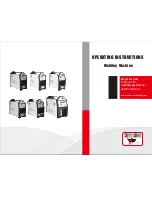
8
Fig. 2 - Exploded View of Torch
twist does not interfere with another part or the in-
side of the handle.
Reposition the pliers about 1/8-in. from the hose and
twist an additional 1-1/2 turns.
5.
Snip off excess wire about 1/8-in. from hose and
bend the twisted ends as shown below.
6.
Snip off the ear of the hose clamp by cutting into the
sides with pincers.
1.
To replace the water hose assembly proceed as follows:
Clean off barbed fitting, and then brush on some
Loctite Prism 447 (P/N 71201202-20gm tube) onto
the fitting.
2.
Slide the hose clamp over the hose.
3.
Push hose into the short water connection tube of
the torch body and tube assembly. Position the hose
clamp over the grooved section of the short tube.
4.
Crimp the ear of the hose clamp with pincers.
5.
Rotate the hose clamp so the ear is positioned close
to the power connection tube as shown in Section
“A-A” of Figure 3.
6.
C. NOZZLES
Adherence of spatter can be minimized and removal
made easier by coating the inside of the nozzle with No.
65 Nozzle Compound (4-oz. container - 08N65; 1 quart
container - 08N75). If insulator liner is damaged or
cracked it should be replaced.
D. CENTERING BUSHING
(Refer to Figs. 2 &3)
To remove the centering bushing (17782) for inspection
or replacement, first shut off power source and then re-
move nozzle, contact tube, and collet nut. Insert the
centering bushing removal tool (996300, supplied with
the torch) through two adjacent bushing slots and then
hook over two opposite bushing ribs. The centering bush-
ing can then be removed by pulling the tool straight out.
If centering bushing is wedged against the nozzle body,
do the following:
Loosen the two No. 10-32 handle locking screws and
pull back handle enough to clear the locking nut
(598787).
1.
Holding nozzle body (598885), loosen locking nut at
least one turn.
2.
Remove centering bushing as described above.
3.
E. TORCH GAS SHIELDING
(Refer to Figs. 2 &3)
Excellent gas coverage is assured by laminar gas flow
techniques and efficient cooling. Any water leakage into
the gas stream area, however slight, will disturb gas
coverage and weld quality. If gas coverage falls below
the desired level, tighten the torch locking nut a quarter
turn, purge the torch with shielding gas for a moment
and return to service. If this does not correct the condi-
tion, the entire body and tube assembly should be re-
moved to permit clearing the internal components of any
collected spatter particles and then reassembling.
F. GASKET AND END FITTING
(Refer to Figs. 2 &3)
To remove gasket (633884) or wire guide and fitting
(996403) for replacement or inspection purposes, pro-
ceed as follows:
With power source turned off, disconnect all torch
service lines.
1.
Remove nozzle, contact tube and collet nut.
2.
Loosen the two setscrews on locking nut (598787)
and pull back torch handle (lever switch attached)
enough to allow locking nut to rotate freely.
3.
Unscrew the locking nut from the nozzle body
(598885)
4.
Pull the nozzle body away from wire guide assem-
bly (997027). The centering bushing (17782) will
fall free at this point.
5.
Check the gasket for cracks and deformed sealing
surfaces. When replacing the old, or installing a new
gasket, apply a thin film of silicone grease (17672)
to the O.D. and sealing surfaces of the gasket.
6.
To remove the wire guide end fitting (996403), clamp
the curved wire guide assembly and then unscrew
the end fitting using a 7/16-in. open-end wrench (note
that the end fitting and wire guide are connected via
a 1/8”-27 tapered pipe thread).
7.
(Continued on page 10).
GASKET SEAL
(2) SETSCREW
WIRE GUIDE
ASSEMBLY
CENTERING BUSHING
NOZZLE BODY
ASSEMBLY
END FITTING
INSULATOR SLEEVE
LOCKING
NUT
HANDLE






























